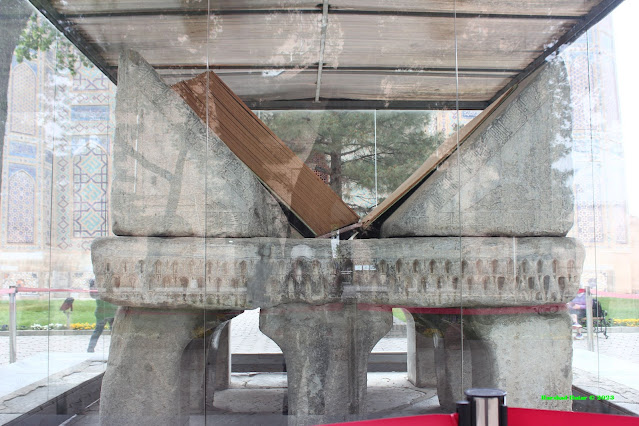SAMARKAND
Introduction. Situated almost in the centre of Uzbekistan, Samarkand is yet another famous and historic city of Uzbekistan. This city has been in existence since 7 BCE. Once upon a time, Bukhara and Samarkand were the biggest cities on the Silk Road between China and Europe. There is evidence that Alexzander the Great in 329 BCE.
Today, Samarkand is the second-largest city in Uzbekistan, with a population of about 5 Lakh. Historically and even now, this city is a melting pot of cultures and an important centre for education.
This city is divided into two parts. Historic Samarkand has all the old buildings, some dating from Timur's time when Samarkand was the capital of Timur. The modern part of Samarkand was built during the Tsarist era when Samarkand was won over by the Russian Empire.
How to Reach Samarkand.
By Air. Well-connected with major cities across the region including Moscow and Saint Petersburg, Istanbul, etc. as well as Tashkent, it is easy to reach this city by air.
By Rail. Samarkand is also connected by High-Speed rail with Tashkent and Bukhara. Slower trains are also available but surprisingly they also cost nearly the same as High Speed trains.
By Road. Road connectivity between all the major cities of Uzbekistan exists but road travel is slower and less comfortable compared to rail and air travel.
Stay Options at Samarkand.
Samarkand is the most well-known destination in Uzbekistan, and stay options are the last of the worries. It boasts of all ranges of hotels, a variety of B & Bs, Boutique hotels and hostels offering bunk beds and private rooms.
These accommodations are available around Registan Square and also the Russian part (fully local but known as the Russian Part as that is where Russians were when Uzbekistan was part of the USSR). Russian part is supposed to have some nightlife too.
The range of budget is also as vast as the available choices. Hence, worries about accommodation should not bother any traveller.
Food Options in Samarkand.
Samarkand is a foodie's paradise for Uzbek food. A variety of Kebabs, Pilaf (Pulav) , and various meat dishes are the attractions of Uzbek cuisine. Availability of Indian food is limited. Internet searches show just two places where Indian food is available.
However, an Indian man from Bangalore opened an Indian Restaurant in Samarkand in 2022. It is called "The Indian Kitchen" which is located about two km from Registan Square and is listed on Google Maps.
But if one is comfortable eating non-veg food, Uzbekistan in general and Samarkand in particular is a place to be.
Moving around in Samarkand.
The best way to move around is by Yellow taxis, which are easily available and not costly. They have a fixed fare for a trip within the town and another fare for trips to the outskirts.
Another option is Tram. Trams are comfortable but have very limited reach. One can travel by tram between the railway station and Siyab Bazar.
City Buses do exist, but they are confusing and complicated. Though cheap, they are better avoided.
Places worth a visit in Samarkand.
Samarkand, once one of the most prominent stops on the Silk Route, is, full of monuments worth visiting.
Registan Square.
The most well-known and famous landmark in Samarkand is a trio of three famous buildings, Tillya Kori, a stunning building with a lot of decors in golden colour, and it contains a small mosque, Sherdor Madarasa and Ulugh Beg Madarasa.
 |
| Registan Square, Tiliya Kori in the center |
 |
| Tilliya Kori |
 |
| Ulughbeg Madarasa |
 |
 |
| Tiliya Kori |
 |
| Motifs of Sun, Tiger and Deer on the main gate. |
Registan, meaning Desert in the Persian language, actually means city square in Uzbek parlance. This place came into being between 1369 and 1405 CE.
These three above-mentioned buildings are some of the well-preserved monuments of that era, however, they also have had their share of neglect and had to be renovated. Here are some shots of photographs of the renovation time.
The courtyard between these three buildings is huge and that helps visitors photograph the facade of the buildings well. Visiting Registan Square in the night is a great experience, with the whole square looking stunningly beautiful in its night illumination.
 |
| Night Mood of Registan. This picture is a bit blurred but kept it here to show the beauty |
 |
| Just stunning |
 |
| Enjoy the Grandure |
 |
| Vertical Panorama |
 |
| Intricate Inlay Work |
 |
| Gur-e-Amir Complex |
 |
| A long shot |
 |
| Inlay work at the gate |
 |
| Inside |
 |
| A Carved wooden door |
 |
| Kabragah, the Graveyard of male members of Amir Timur and his Guru |
 |
| This tank was supposed to keep Pomegranate juice to be fed to soldiers before war (Not sure of it) |
 |
| Night mood of Gur-e-Amir |

















Nice & Interesting Read
ReplyDeleteThank you
Delete